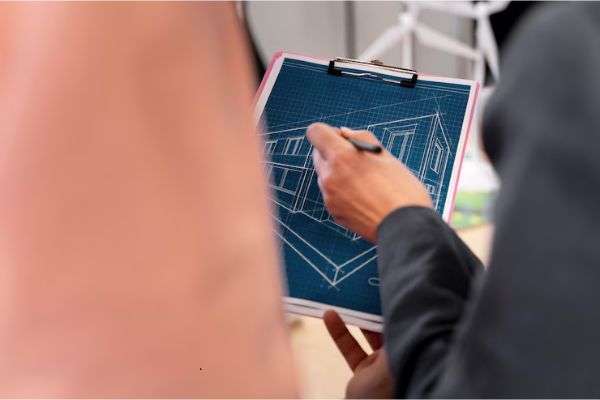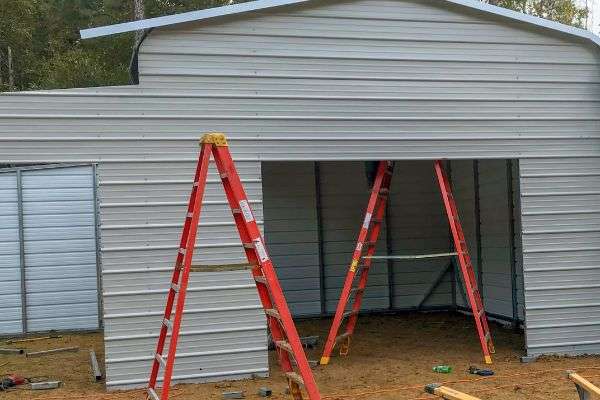Customizing Metal buildings can offer unmatched versatility for customization. Whether planning a workshop, home, or business space, high-quality metal structures provide endless possibilities. Modern steel building customization transforms basic shells into perfectly tailored spaces. Today’s prefabricated metal structures adapt to virtually any use.
Picture this: Sarah bought a standard metal building for her property. She envisioned a thriving pottery studio and gallery space. Six months later, her plain structure remained completely unchanged. Frustration mounted as opportunities and clients slipped away. She felt overwhelmed by countless customization options available. Then she discovered proven customization strategies that transformed everything. Her building became a stunning creative space within weeks. Now her business thrives in the perfect environment.
This comprehensive guide reveals proven customization methods for any purpose. You’ll discover practical solutions that maximize your investment value. From basic modifications to complete transformations, we’ll cover everything. Let’s explore how to create your perfect customized space.

Understanding Metal Building Customization Basics
Metal building customization starts with understanding your options. Every modification serves a specific purpose. Smart planning prevents costly mistakes later.
Foundation of Customization Options
Structural adaptations form the backbone of any successful project. Versatile metal building solutions accommodate various modification types effectively. Consider load-bearing requirements before making any structural changes. Professional engineering ensures both safety and complete code compliance. Many owners underestimate the importance of thorough planning phases. Your foundation choices impact every future modification significantly. Climate conditions strongly influence which customization options work best. Regional building codes may restrict certain modification types entirely. Always verify local requirements before starting any work. Successful projects begin with thorough research and detailed planning. Understanding available options prevents costly mistakes and delays. Each customization choice affects overall project success dramatically. Smart planning creates seamless integration of all modifications.
Essential Planning Considerations
Budget allocation requires extremely careful thought and strategic prioritization. Most customization projects exceed initial estimates by 20-30% typically. Factor in permits, specialized labor, and premium material costs. Timeline expectations should include substantial buffer periods for delays. Weather conditions affect construction schedules significantly throughout the year. Supply chain issues may impact material availability unexpectedly. Clear communication with contractors prevents misunderstandings and costly disputes. Document all agreements and change orders properly and thoroughly. Regular progress checks keep projects on track effectively. Quality control measures ensure lasting results meeting all expectations. Contingency planning addresses unexpected challenges that arise during construction. Detailed specifications prevent confusion between owners and contractors. Written agreements protect both parties throughout the customization process.
Choosing the Right Building Type
Different building styles offer dramatically unique customization potential overall. Clear-span designs provide maximum interior flexibility without obstructions. Multi-section buildings suit complex layout requirements and diverse uses. Roof pitch affects both aesthetics and critical functionality aspects. Higher pitches accommodate loft spaces and ensure better drainage. Personalized steel structures match specific industry needs and requirements perfectly. Agricultural buildings require vastly different features than retail spaces. Manufacturing facilities need specialized ventilation and strategic access points. Consider future expansion possibilities during the initial selection process. The right foundation supports long-term growth and adaptation needs. Building orientation impacts natural lighting and energy efficiency significantly. Site preparation costs vary based on chosen building types. Proper selection eliminates expensive modifications later in the process.

Core Customization Strategies and Methods
Strategic customization transforms basic structures into exceptional spaces. Each modification should enhance functionality and value. Smart choices create lasting improvements.
Exterior Modification Techniques
Exterior customization dramatically improves both curb appeal and functionality. Siding options range from traditional metal to realistic wood-look panels. Color choices affect both aesthetics and crucial energy efficiency. Lighter colors effectively reflect heat in warm climate regions. Darker tones provide sophisticated appearances for upscale commercial applications. Strategic window placement maximizes natural light and ventilation benefits. Durable garage options include various door configurations and custom sizes. Overhead doors accommodate different vehicle heights and specialized equipment needs. Entry doors create memorable first impressions for visitors and clients. Covered porches and overhangs add significant architectural interest and value. These features also provide essential weather protection and cooling shade. Exterior lighting enhances security while highlighting architectural features beautifully. Landscaping integration softens industrial appearances and improves property aesthetics.
Interior Space Optimization
Interior modifications unlock your building’s full potential dramatically and efficiently. Partition walls create separate rooms and essential privacy areas. Open floor plans suit modern living and flexible working styles. Strategic placement of utilities simplifies future modifications and upgrades significantly. Ceiling treatments effectively hide structural elements while improving acoustics. Insulation choices impact both comfort and energy costs long-term. The U.S. Department of Energy recommends specific R-values for different climate zones. Proper vapor barriers prevent costly moisture damage issues effectively. Electrical systems should substantially exceed minimum requirements for flexibility. Plan for comprehensive technology integration and future power needs. Consider creative floor plans for modern metal buildings carefully. These designs maximize every square foot of available space. Thoughtful layouts improve workflow and daily functionality for users.
Advanced Structural Modifications
Complex modifications require professional engineering and extremely careful execution. Mezzanine additions effectively double usable space without expanding footprints. Load calculations ensure complete safety and structural integrity always. Strategic column placement affects traffic flow and space utilization. Clear-span designs eliminate all interior obstacles and constraints completely. Commercial-grade facilities often incorporate highly specialized structural features. Crane systems require substantially reinforced framing and concrete foundations. Large door openings need proper header support and lateral bracing. Roof modifications safely accommodate HVAC equipment and natural skylights. Building a strategic digital presence helps contractors showcase customization expertise. Professional modifications increase property values by 20-40% typically. Engineered solutions ensure code compliance and long-term structural stability. Investment in quality modifications pays dividends through enhanced functionality.

Implementation and Application Guidelines
Successful implementation requires systematic approaches and attention to detail. Each phase builds upon previous work. Careful execution ensures professional results.
Phase-by-Phase Implementation Process
Project phasing prevents overwhelming complexity and significant budget overruns. Foundation work must precede all other structural modifications completely. Utility rough-ins happen before any wall installations can begin. Exterior work should complete before interior finishing work starts. This sequence prevents expensive damage and frustrating rework issues. Weather-resistant modifications take absolute priority in harsh climate regions. Schedule flexibility accommodates unexpected delays and necessary design changes. Material deliveries require precise coordination with specific work phases. Secure storage planning prevents damage and costly theft losses. Regular inspections catch developing problems before they escalate significantly. Detailed documentation helps with warranties and future modification projects. Phase completion milestones trigger payment schedules and progress evaluations. Systematic approaches ensure professional results throughout the entire project.
Best Practices for Quality Results
Quality workmanship ensures modifications last for multiple decades reliably. Hire contractors specifically experienced with metal building systems exclusively. Thoroughly verify licenses, insurance, and references before signing contracts. The American Institute of Steel Construction provides comprehensive industry standards. Following manufacturer specifications maintains all warranty coverage properly and completely. Use only compatible materials to prevent damaging galvanic corrosion. Proper fastener selection prevents loosening, leaks, and structural failures. Sealants must precisely match application requirements and temperature ranges. Regular maintenance preserves substantial customization investments over extended time. Create detailed maintenance schedules for all modified building components. Professional installation consistently beats DIY attempts for complex modifications. Quality control checkpoints throughout construction ensure specification compliance. Experienced contractors anticipate challenges and provide effective solutions quickly.
Common Considerations in Customizing Metal Buildings
Every project faces similar challenges requiring thoughtful, practical solutions. Permit requirements vary significantly between different jurisdictions and municipalities nationwide. Research all local codes before finalizing any design plans. Budget contingencies should equal 10-20% of total project costs. Hidden problems often surface unexpectedly during modification work phases. Structural surprises may require immediate engineering solutions and approvals. Timeline padding prevents stress and potentially rushed decision making. Clear communication protocols keep all involved parties properly informed. Change orders formally document modifications to original construction plans. Protective carport designs showcase simpler customization projects quite effectively. These examples demonstrate easily achievable results for beginning builders. Starting small builds essential confidence for tackling larger projects. Learning from others’ experiences prevents common mistakes and oversights.

Advanced Customization Topics and Results
Advanced modifications push boundaries of traditional metal buildings. Innovation creates unique solutions for specific needs. Technology integration modernizes these versatile structures.
Sustainable Customization Options
Eco-friendly modifications significantly reduce environmental impact and operating costs. Solar panel integration requires proper roof reinforcement and optimal orientation. The Green Building Council certifies sustainable building practices nationwide comprehensively. Rainwater harvesting systems provide reliable irrigation and emergency water supplies. Green roofs effectively insulate while managing stormwater runoff naturally. Energy-efficient windows dramatically reduce heating and cooling demands year-round. LED lighting cuts electricity usage by an impressive 75% minimum. Smart thermostats optimize HVAC operations automatically for maximum efficiency. Recycled materials substantially reduce construction waste and project costs. Sustainable choices often qualify for valuable tax incentives and rebates. Professional visibility solutions help green builders reach clients. Environmental considerations influence modern customization decisions increasingly. Sustainable features attract environmentally conscious tenants and buyers consistently.
Measuring Customization Success
Success metrics extend far beyond simple aesthetic improvements alone. Functionality improvements should meet all original project goals completely. Energy efficiency gains translate into substantial measurable monthly savings. Comfort levels increase noticeably with proper insulation and ventilation. Property values typically increase 15-30% following quality customization projects. The National Association of Home Builders tracks renovation return rates. User satisfaction surveys reveal practical improvement areas needing attention. Maintenance requirements should decrease significantly with quality modification work. Durability testing confirms long-term performance expectations are met consistently. Interior design ideas for metal building homes enhance comfort. Regular evaluations guide future improvement decisions and investment priorities. Performance metrics validate customization choices and document return on investment. Successful projects balance aesthetics, functionality, and financial considerations effectively.
Future-Proofing Your Investment
Forward-thinking modifications accommodate rapidly changing needs over extended time. Modular designs allow easy reconfiguration as business requirements evolve. Technology infrastructure supports advanced smart building features and automation. The International Building Code updates reflect emerging standards regularly. Structural capacity exceeding current needs enables seamless future additions. Utility systems sized for expansion prevent extremely costly upgrades. Strategic access points facilitate equipment updates and routine maintenance. Documentation systems meticulously track all modifications and warranty information. Comprehensive online frameworks help builders showcase capabilities. Planning for inevitable change maximizes long-term building investment value. Future-ready buildings consistently command premium prices in any market. Flexibility features reduce renovation costs when needs change unexpectedly. Smart investments today prevent expensive modifications tomorrow.
Frequently Asked Questions
How much does metal building customization typically cost?
Customization costs vary widely based on scope and complexity. Basic modifications like windows and doors average $5,000-$15,000. Extensive customizations including interior buildouts can reach $50,000 or more.
What customizations require building permits?
Most structural modifications require permits, including adding windows, doors, or interior walls. Electrical and plumbing work always needs permits. Check local building departments for specific requirements in your area.
Can I customize a metal building after construction?
Yes, metal buildings accommodate post-construction modifications well. Many owners add features gradually as budgets allow. Ensure modifications comply with original engineering specifications.
How long do customization projects usually take?
Simple modifications complete within 2-4 weeks typically. Complex projects involving multiple trades may require 2-3 months. Weather and permit delays can extend timelines significantly.
Do customizations void manufacturer warranties?
Properly executed modifications shouldn’t void warranties. Use approved contractors and follow manufactu


